-2023-1000.jpg)
Jan Pimblett, Bound(aries), 2023. Edinburgh Sculpture Workshop (ESW). Photo: Dianne Barry.
Various venues, Edinburgh
9-25 August 2024
by BETH WILLIAMSON
This year’s Edinburgh Art Festival (EAF24), now in its 20th year, might be summed up in three words – place, politics and persistence. Pulled together by an overarching ethics of care, the programme for 2024 invites audiences “to join them in a moment to collectively pause and reflect upon the conditions under which we live, work, gather and resist”. It is a tall order in present times, but a necessary one if we are to become more fully cognisant of the inequalities that isolate individuals, destroy communities and, at times, fill both with little else but a profound sense of hopelessness. It is easy to fill our thoughts with all that is wrong in the world, to recognise references to global problems everywhere we look, including in the work of contemporary artists responding to those problems. More difficult, is to highlight the problems in a meaningful way that allows room for reflection and also for hope that, collectively, we can still build a better future. That is the ambition of EAF24 under the directorship of Kim McAleese.
There is no silver bullet, but this programme digs deep and recognises an urgency for change that many of us feel, while also offering possible ways forward. As McAleese says: “In these current times we are living through, we want to connect to our context and the city – to the people and movements who inspire change, who enable solidarity and bring people together to work towards collective futures. Although McAleese doesn’t mention it, what she is talking about might well be summed up by the clarion call popularised by the Scottish artist and writer Alasdair Gray: “Work as if you live in the early days of a better nation”, an axiom he paraphrased from a poem by the Canadian poet Dennis Lee.
The question, I suppose, is how you do all that in an art festival, and this programme provides an eminently valid response. Thinking across its 20-year history, EAF24 reflects on a period that included 14 years of a Conservative government and the UK’s withdrawal from the European Union, austerity and Covid, and a Scottish independence referendum. Across that same period, we have seen the rise of fascism and xenophobia, and resistance to those things, as well as increased awareness of post-colonial legacies and ecological crises. The artists included in this roster of exhibitions and performances all engage with these issues and concerns in different ways, whether directly or obliquely.
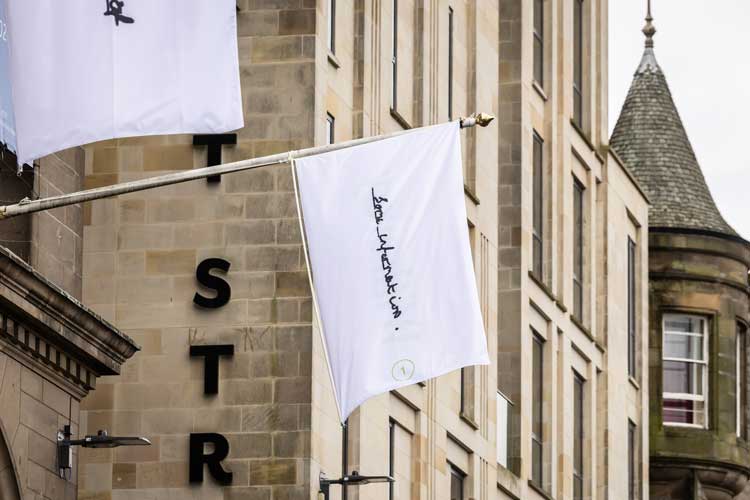
Rosie’s Disobedient Press. Flags, posters, wearables and events, various locations around Edinburgh.
Some of the bigger shows in the programme are those longer-running ones that really do pack a punch – El Anatsui’s Scottish Mission Book Depot Keta at Talbot Rice Gallery, Ibrahim Mahama’s Songs about Roses at Fruitmarket, and Women in Revolt! at Modern Two – and have been written about widely in their current or previous iterations. For that reason, I want to focus on the smaller exhibitions at the heart of this festival and scattered around the city. Further, this makes sense because resistance of all sorts starts small and often exists around the edges, something that artist-led Rosie’s Disobedient Press explores in flags, posters, wearables and events at 19 locations around Edinburgh, all concerned with the recent history of resistance in the city.
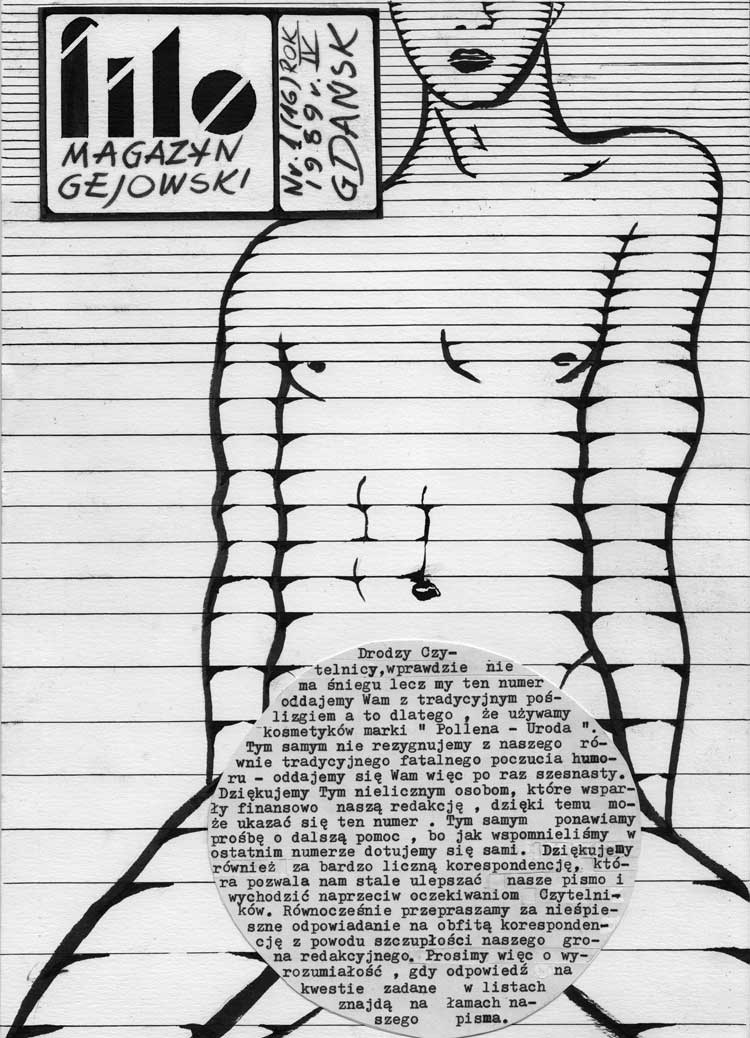
Filo magazine, No 16, 1989. Queer Archives Institute collection.
Acting as an anchor for the entire programme are the various exhibitions at City Art Centre (CAC). It may be geographically central, but the underpinning message is to exceed the centre and look to the edges for the lost, the lonely and the overlooked, drawing those communities inward to make a larger and more inclusive whole. The exhibition Filo by Karol Radziszewski traces the history of Filo, an early underground queer magazine from Poland, founded by the activist Ryszard Kisiel. The approach taken by Radziszewski is first to share vitrines of archival material, such as photographs, ephemera and back issues, in order to reflect the central place of research in his curatorial work. This is also a strategy that foregrounds the legitimacy of the magazine and related material, which was considered an amateur endeavour at the time of publication, despite its role in furthering activist conversations about sexuality, creativity and politics.
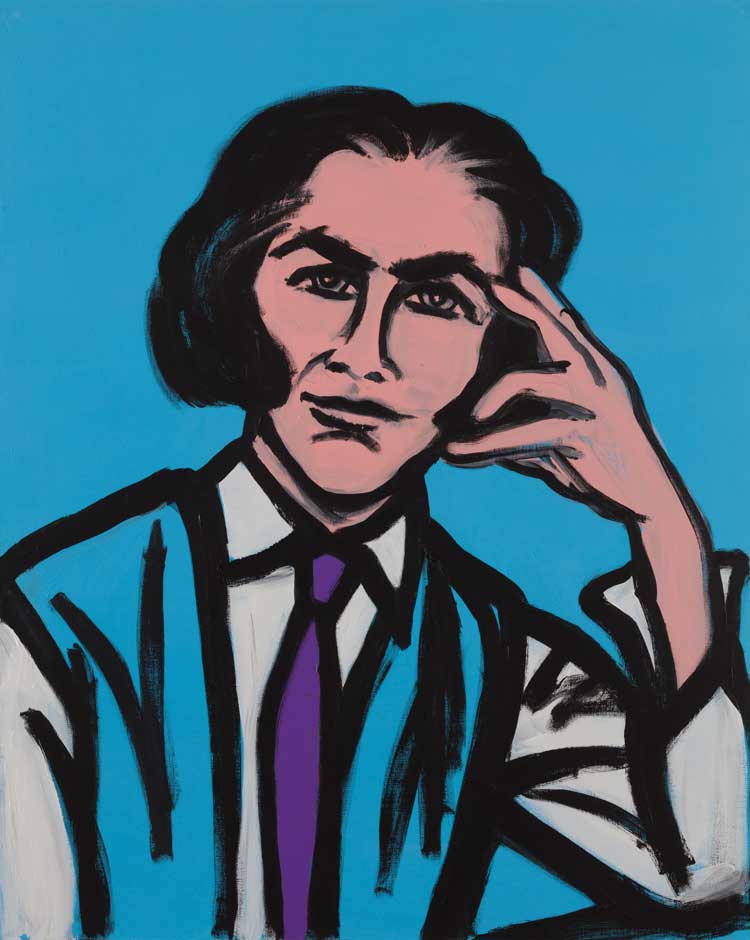
Karol Radziszewski. Veronika Šleivytė. Gallery of Portraits series, 2021.
Alongside this archival history of Filo, a magazine produced in response to Polish police suppression of sexual minorities, Radziszewski shows a series of his paintings of queer central-eastern European historical figures. These acid-coloured portraits of figures such as the Lithuanian artist and photographer Veronika Šleivytė and the Belarusian chess player Eugenij Ruban are cast in the style of eastern bloc propaganda portraits.
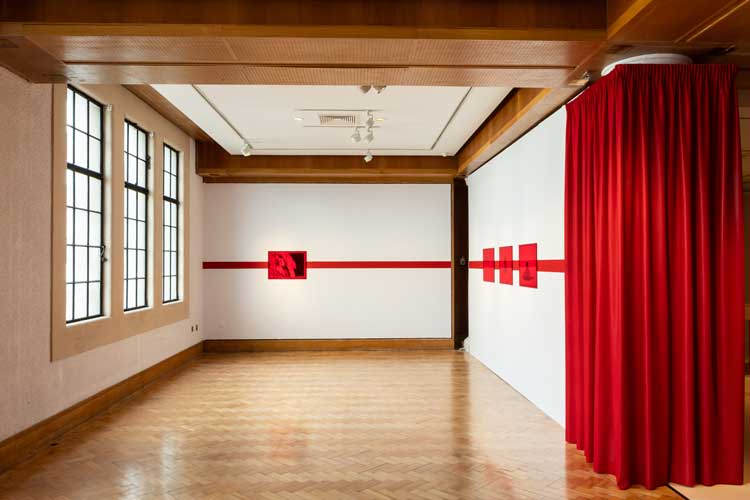
Renèe Helèna Browne, Sanctus! Film installation. City Art Centre (CAC).
Elsewhere at CAC, Renèe Helèna Browne’s new film installation Sanctus! is a sincere exploration of the artist’s relationship with their mother Helen, as well as Helen’s relationship with faith, death and the afterlife. It is an intensely personal contemporary portrait of a close familial relationship which, at the same time, allows the viewer room to reflect more broadly on relationships and the social and cultural frameworks that contextualise them. Browne’s approach is one of the most inventive I have seen in a long time. It would be tricky to tackle such difficult issues head-on, so Browne approaches them indirectly through the curious lens of rally driving culture in County Donegal in Ireland – we see, for instance, a three-day rally in Letterkenny. This high-octane hobby with its bold colours and graphics is something Browne’s late uncle was passionate about. The red leather of his rally car seats is a colour that stays with the artist not because of its uniqueness, but because of its commonness, a place they can meet him in the everyday. Filming over the course of a year, Browne shares compelling conversations with their mother, Helen, that consider her as somehow a survivor of her own life. Despite the relational context, the focus here, as Browne explains, is on how Helen feels, not on how Browne feels. Browne implores viewers: “Don’t just pull away.” The implication is that when familial relationships get tricky, you should not withdraw, but rather take a moment to listen, to try to understand. It is a call for care and caring, however difficult those things might be.
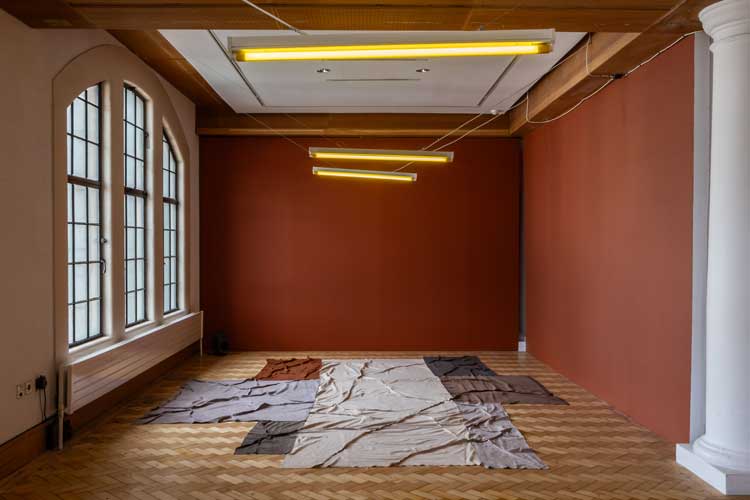
Alaya Ang, The Fingers Pulling the Thread. Platform. Photo: Sally Jubb Photography.
Platform, the annual early career artist award at EAF is in CAC, too, this year. Four artists – Alaya Ang, Edward Gwyn Jones, Tamara MacArthur and Kialy Tihngang – all show work focusing on questions of intimacy, material memory, protest and persecution. Of the four artists, it was Ang’s work that caught not only my eye but my interest. The Fingers Pulling the Thread is a floor-based work showing mud-dyed textiles created in Indonesia and Scotland. This cartographic piece (seams and folds gesture to the rivers and waters that connect people and places) takes its muted monochrome palette of ochre, iron ore, umber, mushroom, from mud from different locations such as the shale bings (spoil heaps) and iron ore mines of West Lothian around Edinburgh and the paddy fields of Indonesia, for instance. The method is based on a traditional of seasonal communal mud-dyeing in Guangdong (Canton) between May and October. Audiences at CAC are invited to sew or draw on the material to reflect its collective process of production. The artist has a personal history with textiles as their parents own a tailoring business. Still, this textile piece is not the only exchange between Singapore and Scotland here as a recording of the tailoring shop’s ambience creates the soundscape for Ang’s installation.
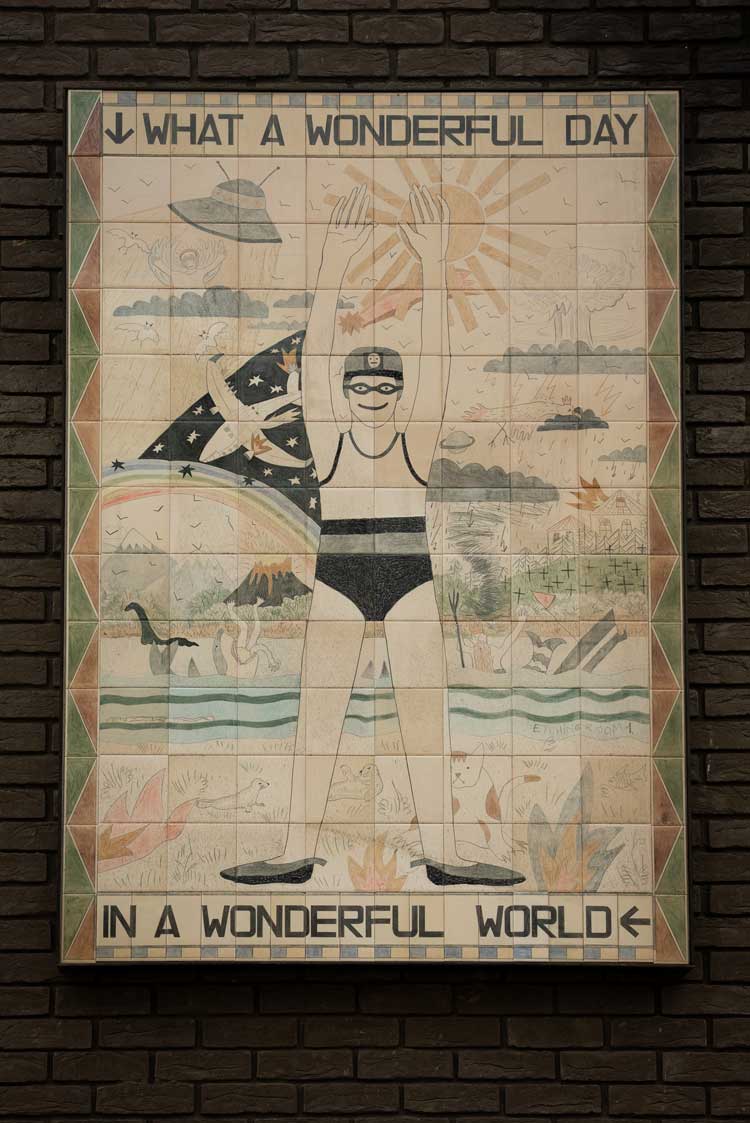
Etching Room 1. A wonderful day in a wonderful world. Mural. Edinburgh Sculpture Workshop (ESW). Photo: Lewis Gourlay.
Over at Edinburgh Sculpture Workshop (ESW), visitors are spoiled for choice once again with three exhibitions. What a Wonderful Day in a Wonderful World is a new public mural by the Ukrainian duo Etching Room 1. A message of hope against a backdrop of horrific events, the mural speaks to the artists’ personal experience of conflict and their resilience in the face of such circumstances. In ESW’s Hawthornvale Space, Jan Pimblett’s Hybrids present a curious collection of artefacts formed into strange beings that appear frozen in time, but only just, as if they might burst into life at any moment and permeate our world with unknown effect. In ESW’s main gallery space, Sequoia Danielle Barnes shows Everything is Satisfactual, an Afro-surreal retelling of Br’er Rabbit and the Tar Baby tales that delves into ideas of cuteness, oppression and marginalisation. It is a difficult but fascinating show.
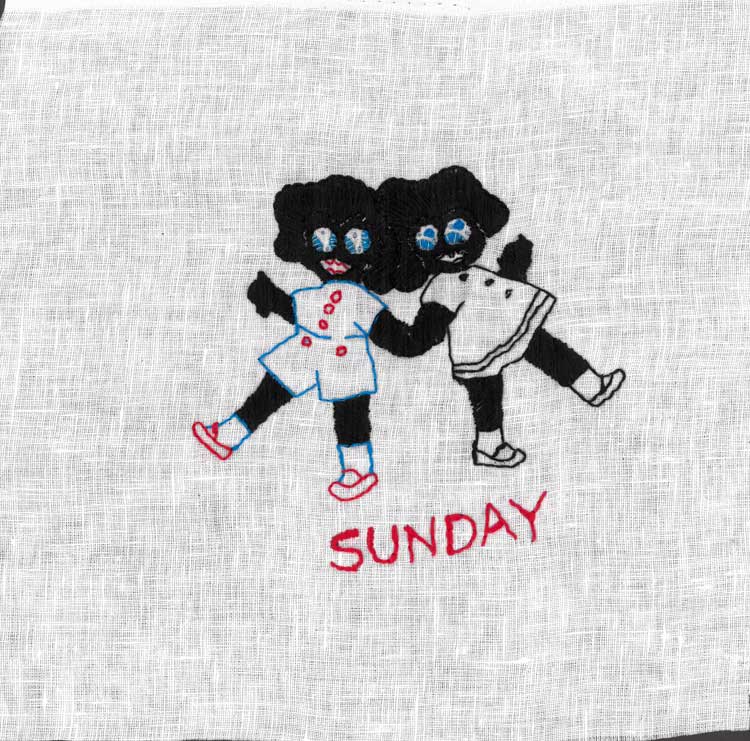
Sequoia Danielle Barnes. Useable Several Times series, 2023. Embroidery on calico. Courtesy the artist.
In Ingleby Gallery’s spectacular old Glasite Meeting House space, Hayley Barker’s exhibition The Ringing Stone is firstly a celebration of the seasons in Barker’s Los Angeles garden. These large-scale paintings seem to enfold us, drawing us in to a luxuriant and welcoming space. It is the details that caught my attention in these works – a lizard in Spring Valentine Path, and wind chimes in Autumn Moon Garden 2, both 2024.
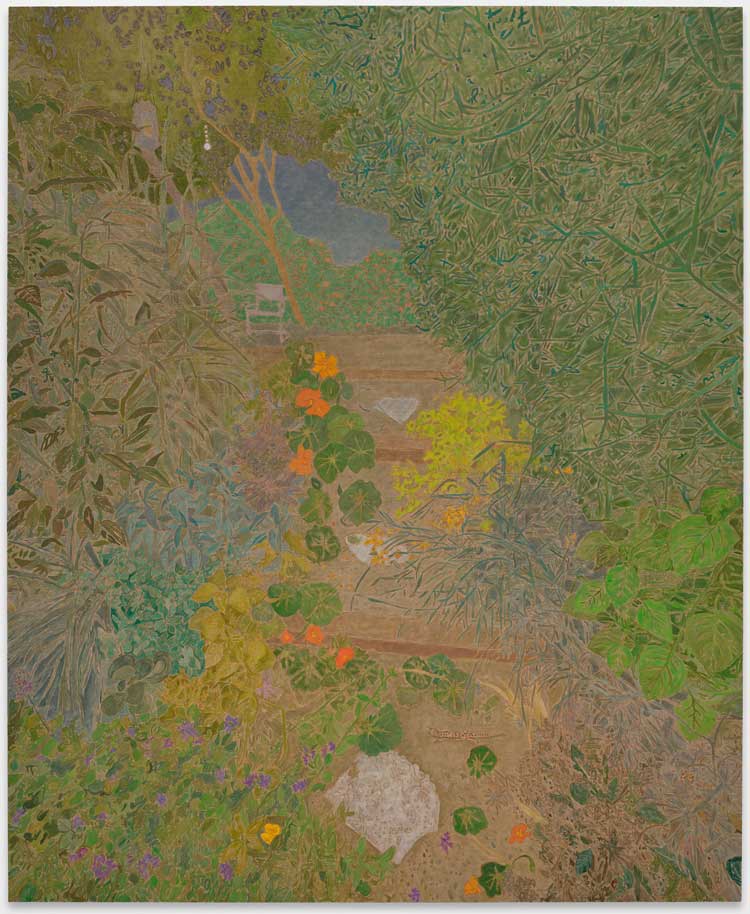
Hayley Barker. Spring Valentine Path, 2024. Oil on linen, 254.3 x 208.3 cm. Ingleby Gallery. Photo: Paul Salveson.
It is astonishing to think that Barker trained on Hans Breder’s legendary intermedia programme at the University of Iowa (famed for video and performance art) and is now producing verdant paintings that hover between landscape and dreamscape. The show also includes the titular work The Ringing Stone (2024), a larger-than-life depiction of the ringing stone Barker encountered between Balephetrish and Vaul on the Isle of Tiree. In Barker’s rendition, the stone appears almost as if located in a desert scene, or as an object of devotion, adding to the pensive atmosphere conjured up by the seasonal paintings, an atmosphere that seems to hold us, just for a moment, as we reflect carefully.
At the top of Calton Hill, Collective celebrates its 40th birthday year with two exhibitions from artists at very different stages of their careers. Kaya Fraser is an emerging artist whose two-channel video installation Give Us a Smile explores grief from different perspectives and connects to her wider practice of working with her own family and offering a voice to working-class lives. Her idea of “scheme sublime” investigates working-class lives from within, foregrounding community and joy rather than poverty and hardship.
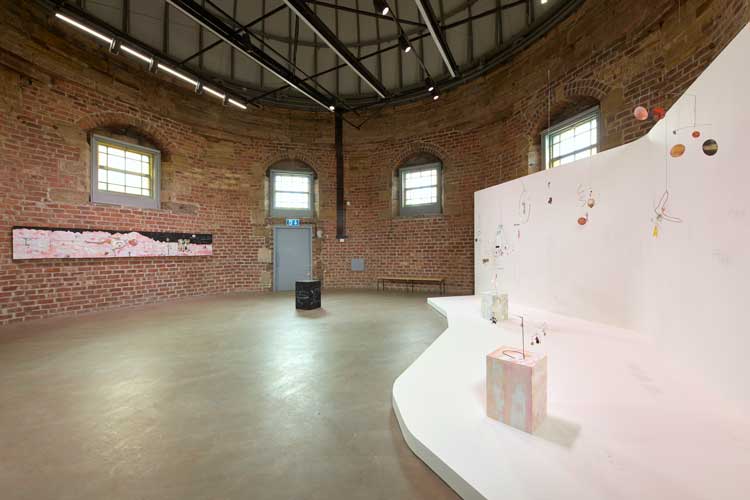
Moyna Flannigan, Space Shuffle, Collective, 2024. Photo: John McKenzie.
The other exhibition is by Moyna Flannigan, an artist established in her career and known for collage works. Flannigan has long been associated with Collective and regularly exhibited there in the 1990s at its former home in Edinburgh’s Cockburn Street. Now she responds to its current home in a former historic observatory with Space Shuffle, a show that includes a large wall-based frieze-collage, Looking for Pluto (2024), but also moves into three dimensions. Flannigan’s delicate three-dimensional collage-sculptures sit lightly in this space. They exist as drawings in space that, in their current formation at least, establish dialogues with each other and open up opportunities for new conversations with viewers. This is an exhibition that can be considered as emblematic of the ambitions of EAF24. Looking backwards in order to move forwards, looking to the edges in order to understand them more fully and bring them into the fold, giving a voice to an artist who has persistently followed her own path and now has an opportunity to develop her practice afresh.
Descending Calton Hill and walking back into the city centre, I reflect on what I have experienced over the couple of days I have been journeying around Edinburgh and EAF24. There are no miracle cures, no magic solutions, the enormity of the problems outlined at the start see to that. Yet, EAF24 has helped me to slough off that feeling of hopelessness and engage a more resilient approach, recognising the power of collectivity and how even the smallest acts can effect change for the better. Maybe it can help you too.